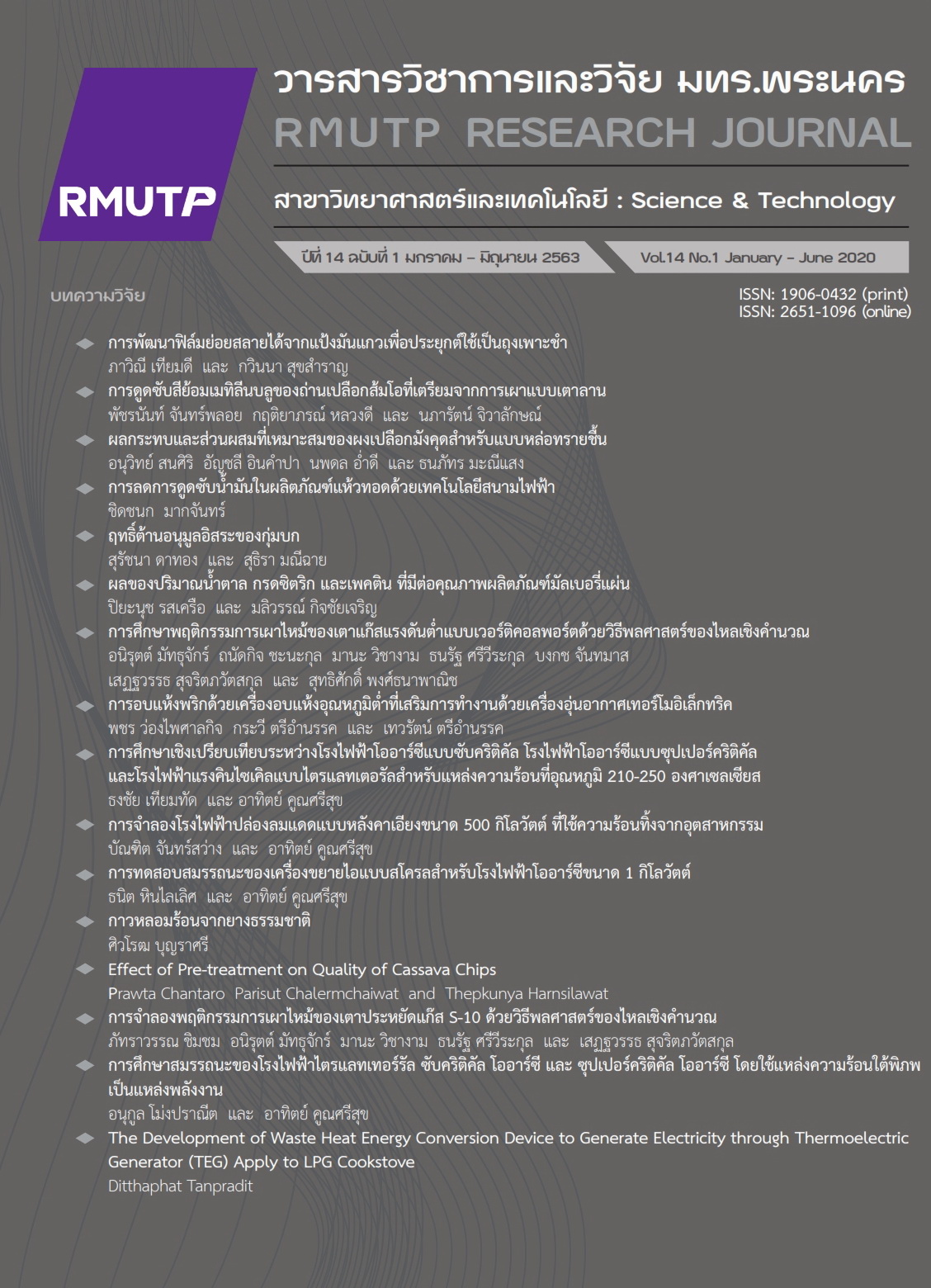Methylene Blue Adsorption Using Pomelo Peels Charcoal Prepared by Traditional Charcoal Burning
Main Article Content
Abstract
The pomelo peels charcoal was successfully prepared by traditional charcoal burning and its adsorption of methylene blue was investigated. The influences of methylene blue adsorption including contact time and methylene blue initial concentration were studied at room temperature. The adsorption rate initially increased rapidly until 24 h and 600 mg/L of methylene blue initial concentration. The further increase in contact time and methylene blue initial concentration did not significantly increase the adsorption due to it reached equilibrium. Kinetic of adsorption were investigated, that the pseudo-second order model best described adsorption kinetic data. The adsorption isotherms were evaluated and the data correlated with Langmuir adsorption model with the maximum adsorption capacity was found to be 166.67 mg/g. The adsorption of pomelo peel charcoal was studied comparing to other adsorbents at the same experimental conditions. The results showed higher adsorption of pomelo peel charcoal than dried pomelo peel, longan wood charcoal, coconut shell charcoal, litchi wood charcoal and tamarind wood charcoal, respectively.
Article Details
References
X. Liu, Z. Ni, C. Xie, R. Wang and R. Guo, “Controlled synthesis and selective adsorption properties of Pr2CuO4 nanosheets: a discussion of mechanism,” Nanoscale Research Letters, vol. 13,
no. 268, pp. 1-11, 2018.
K. K. Upadhyay, A. C. Pandey and J. Manzoor, “Impact of dyes on the chemistry of water and its implications: a review,” Bio Bulletin, vol. 3, no. 1, pp. 1-7, 2017.
W. Sarakarnkosol, “Pollution and the dangers of waste water from dyeing clothes,” Environment Journal, vol. 21, no. 1, pp. 7-14, 2017.
Z. Wang, M. Xue, K. Huang and Z. Liu, “Textile Dyeing Wastewater Treatment,” in Advances in Treating Textile Effluent, P. Hauser, Ed. China: InTech, 2011, pp. 91-116.
E. A. S. Almaamary, S. R. S. Abdullah, H. A. Hasan, R. A. Ab. Rahim and M. Idris, “Treatment of methylene blue in wastewater using Scirpus grossus,” Malaysian Journal of Analytical Sciences, vol. 21, no. 1, pp. 182-187, 2017.
J. Thuanthong, “Removal of reactive dye wastewater by chemical coagualation,” M.S. thesis, Dept. Environ. Eng., Chulalongkorn Univ., Bangkok, Thailand, 2010.
P. Jitto, T. Chaikratang and W. Nakbanpote, “Silk textile wastewater treatment by electrocoagulation process,” Journal of Research Unit on Science, Technology and Environment for Learning, vol. 7, no. 2, pp. 228-239, 2016.
T. Kritsanapuk and C. Jarusutthirak, “Decolorization of Synthetic Dyeing Wastewater by Catalytic Ozonation,” in Proceeding of The 54th Kasetsart University Annual Conference, Thailand, 2016, pp. 1107-1114.
R. Srimoon, “Dyes treatment in wastewater using adsorption processes,” KKU Science Journal, vol. 44, no. 3, pp. 419-434, 2016.
M. Kaykhaii, M. Sasani and S. Marghzar, “Removal of dyes from the environment by adsorption process,” Chemical and Materials Engineering, vol. 6, no. 2, pp. 31-35, 2018.
Ministry of Agriculture and Cooperatives. (2019, October). Agricultural Production. [Online]. Available: http://www.agriinfo.doae
.go.th
O. I. Aruoma, B. Landes, D. Ramful-Baboolall, E. Bourdon, V. Neergheen-Bhujun, K-H. Wagner and T. Bahorun, “Functional benefits of citrus fruits in the management of diabetes,” Preventive Medicine, vol. 54, Supplement, pp. S12-S16, 2012.
M. Fatiha and B. Belkacem, “Adsorption of methylene blue from aqueous solutions using natural clay,” Journal of Materials and Environmental Science, vol. 7, no. 1, pp. 285-292, 2016.
C. Umpuch and S. Sakaew, “Removal of methyl orange from aqueous solutions by adsorption using chitosan intercalated montmorillonite,” Songklanakarin Journal of Science and Technology, vol. 35, no. 4, pp. 451-459, 2013.
N. Jiwalak, S. Rattanaphani, J.B. Bremner and V. Rattanaphani, “Equilibrium and kinetic modeling of the adsorption of indigo carmine onto silk,” Fibers and Polymers, vol. 11, no. 4, pp. 572-579, 2010.
U. Gecgel, O. Uner, G. Gokara and Y. Bayrak, “Adsorption of cationic dyes on activated carbon obtained from waste Elaeagnus stone,” Adsorption Science & Technology, vol. 34, no. 9-10, pp. 512-525, 2016.
K. A. Kareem, “Removal and recovery of methylene blue dye from aqueous solution using Avena fatua seed husk,” Ibn Al-Haitham Journal for Pure and Applied Science, vol. 29, no. 3, pp. 179-194, 2016.
R. Saadi, Z. Saadi, R. Fazaeli and N. E. Fard, “Monolayer and multilayer adsorption isotherm models for sorption from aqueous media,” Korean Journal of Chemical Engineering, vol. 32, no. 5, pp. 787-799, 2015.
A. Ritthichai and S. Muncharoen, “Dye removal of textile wastewaters using crab shell activated carbon,” Burapha Science Journal, vol. 19, no. 1, pp. 131-140, 2014.
S. Rattanapan and P. Kongsune, “Methylene blue adsorption onto activated charcoal prepared from mangosteen peel,” Thaksin University Journal, vol. 21, no. 2, pp. 51-59, 2018.
K. Yothawong, L. Singngao, and W. Pongpatrakant, “Preparation of activated carbon from macadamia nut shells by sodium chloride,” in Proceeding of The 1st Loei Rajabhat University Annual Conference, Thailand, 2019, pp. 35-44.


